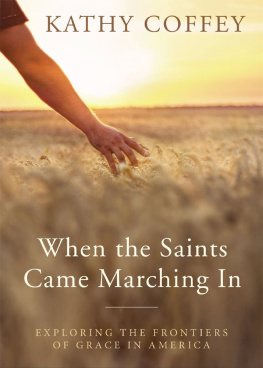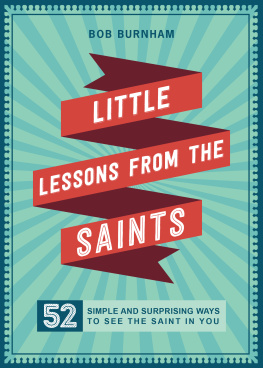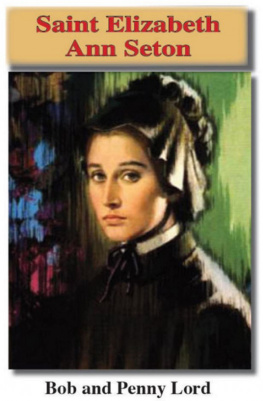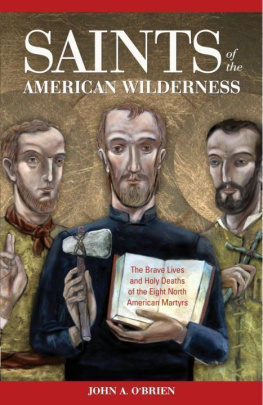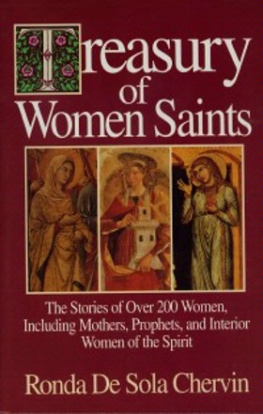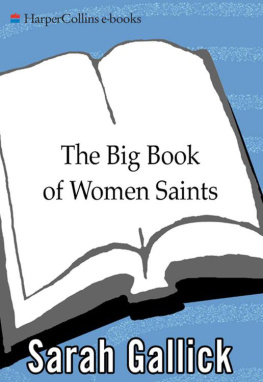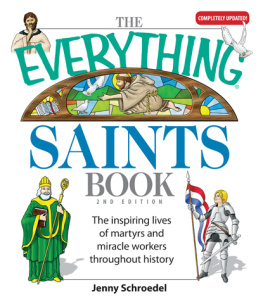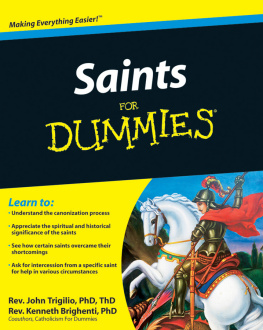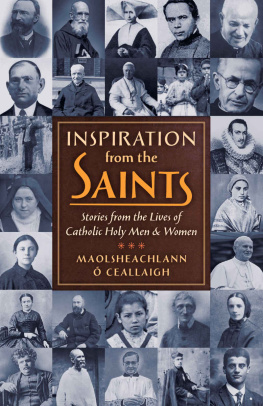Kathy Coffey has given us a book of American saints for the era of Pope Francis. Where her title metaphor focuses on the American penchant for exploring frontiers, the books saintssome canonized, others simply recognizedmade me also think of Francis metaphor of going out to the streets of our world. The saints Coffey covers, in brief readable chapters, are all gutsy realistsa memorable phrase used to describe Sr. Dorothy Stang. And all wonderfully human, warts and all. I learned about saints Id never known, and learned more about others I thought I knew. In the end the book made me think of all the saints among us in this countryso much good news to counter all the bad news that lls our headlines and our heads.
John F. Kane
Emeritus Professor of Religious Studies Regis University
Uh-oh. Here comes marching in a book that wont ever again let us say, But the saints arent anything like us. Read, if you dare, about the courageous, cantankerous, saintly people who lived in America in their time, but changed the world for all time.
Kathy McGovern, author of the weekly Scripture column The Story and You
Kudos to Kathy Coffey for this collection of open, sociable, normal, happy companions, just the kind of saints Pope Francis says we need. In her characteristically engaging and entertaining prose, Coffey helps us entertain the notion that the path toward sainthood is the very ground on which we stand. Be prepared for the spaciousness that emerges in these stories, both in the vast terrain of landscape these men and women traversed and in their very souls. It is in these wide open places that God enters, grace abounds, and lives are transformed in love.
Mary Stommes, editor of Give Us This Day
Cover design by Stefan Killen Design. Cover photo Thinkstock.
Scripture texts used in this work are taken from the New American Bible, revised edition 2010, 1991, 1986, 1970 Confraternity of Christian Doctrine, Washington, DC and are used by permission of the copyright owner. All Rights Reserved. No part of the New American Bible may be reproduced in any form without permission in writing from the copyright owner.
2015 by Kathy Coffey
Published by Liturgical Press, Collegeville, Minnesota. All rights reserved. No part of this book may be reproduced in any form, by print, microfilm, microfiche, mechanical recording, photocopying, translation, or by any other means, known or yet unknown, for any purpose except brief quotations in reviews, without the previous written permission of Liturgical Press, Saint Johns Abbey, PO Box 7500, Collegeville, Minnesota 56321-7500. Printed in the United States of America.
Library of Congress Cataloging-in-Publication Data
Coffey, Kathy.
When the saints came marching in : exploring the frontiers of grace in America / by Kathy Coffey.
pages cm
ISBN 978-0-8146-3718-0 ISBN 978-0-8146-3743-2 (ebook)
1. Christian saintsUnited StatesBiography. 2. Christian biographyUnited States. 3. United StatesChurch history. I. Title.
BX4659.U6C64 2015
282.092273dc23
[B]
2014027642
For my grandson, Henry Joseph
May you walk always among heroes such as these
Contents
Introduction
True holiness is completely unself-conscious. You wouldnt have the slightest awareness of its existence in you. Besides you will not care, for even the ambition to be holy will have dropped as you live from moment to moment a life made full and happy and transparent through awareness.
Anthony de Mello
T he starting point is always the goodness of God. Gods creative genius peopled the fresh terrain of the United States with remarkable women and men. They lived in our country; they walked its paths. They climbed our hills and mountains, sailed our seas, heard our birdsong, looked for stars in our vast skies. They smelled the rain falling on our prairies and forests. Junpero Serra, a Franciscan, and Kateri Tekakwitha, a Native American, wouldve found all outdoors a temple. Eating our food, speaking or learning our language, they worked hard, laughed long, and prayed often.
We in the United States are fortunate to brush elbows with many saints who grew and flourished here. As we explore their stories, its intriguing to imagine them sitting down together at a heavenly banquet, unbounded by the usual human constraints. Their shared values, hopes, beliefs, and actions are strong membranes connecting them beyond time and space. Joining them are their companions, families, and all the marvelous people who unfortunately couldnt fit into this book.
Elizabeth Ann Seton and Pierre Toussaint exchange news about their parish, St. Peters in New York City; she thanks him for donations to the orphanage staffed by her sisters. Katharine Drexel and John Neumann chat about their hometown, Philadelphia. Marianne Cope, the first to admit alcoholics to the hospital at a time when they were jailed instead, thanks Bill W., Dr. Bob, and Sr. Mary Ignatia for founding Alcoholics Anonymous. Martin Luther King Jr. and Cesar Chavez discuss with Henry David Thoreau his essay, On Civil Disobedience. He preferred jail to paying a tax that would finance the Mexican War and extend slavery; his stance on resisting injustice underlay their movements. Rose Hawthorne Lathrop and Elizabeth Ann Seton compare notes on their shared experiences of being widowed, converting to Catholicism when it was most unpopular, losing a child, and constantly caring for the sick. Frances Cabrini and John Neumann discuss immigration with contemporary experts and marvel that the issues of their day still have not been resolved. Thea Bowman and Katharine Drexel roll their eyes about black women being denied admission to religious communities in the early 1900s. Sister Mary Luke Tobin and Rachel Carson measure womens progress in the arenas they pioneered: church and science. Dorothy Day and Helen and Cesar Chavez reminisce about their visits to each other, and Days imprisonment in 1973 for picketing several California vineyards. Dorothy Stang and the sisters martyred in Liberia talk with Jean Donovan, Ita Ford, Maura Clarke, and Dorothy Kazel about the ties that bound them so closely to their people, they couldnt leave their missions even when their lives were endangered.
Those whove had only a nodding acquaintance with hunger and thirst cannot fully appreciate the feast described in Isaiah 25:4-6, covered with rich foods and fine wines. To add a conversation with this cast of characters would make it a five-star banquet indeed!
No book on the North American saints would be complete without mentioning the splendid depiction on the tapestries at the Los Angeles Cathedral. There, Serra and Seton rub elbows with Peter, Mary Magdalene, and Thomas More. They take their place in that great company that focuses all its attention and energies on the altar, the Christ before them. From both sides of the cathedral they press forward, intent on one goal.
Their visible engagement would be tarnished by comparing it to any other crowd, pushing into a sale, a sports event, or a concert. Their hands are often folded in concentration; their eyes light with anticipation of an unfolding feast. None of the saints are actively doing anything else,
The documentary Divining the Human shows the process of creating the tapestries. In a juxtaposition of earthly and heavenly, the music of Pange Lingua and Veni Creator Spiritus drifts over hard hats and scaffolds, clanking metal and the freeways roar. Lead artist John Nava, a committee of liturgists, those who lay cement or tile, drill, sew hems, install lighting: these too are all part of the communion of saints. Mingled in with the saints depicted on the walls are ordinary citizens of Los Angeles: a little boy in tennis shoes, a girl in jeans, a businessman in a suit. Indeed, ordinary Californians were the models for the saints, and they reflect on what that meant: Their qualities arent unattainable or magical. Becoming a saint is a long process, not just Bingo! The Communion of Saints says, I belong. The saints on the tapestries mirror the assembly, which may explain why some of the first viewers got goose bumps. They were seeing themselves. Underlying the art are the biblical phrases, See, Gods dwelling is among mortals. God will dwell with them. They will be Gods people and God will be with them. Small and insignificant as humans sometimes seem, they are nonetheless precious, transcendent saints-in-the-making.

